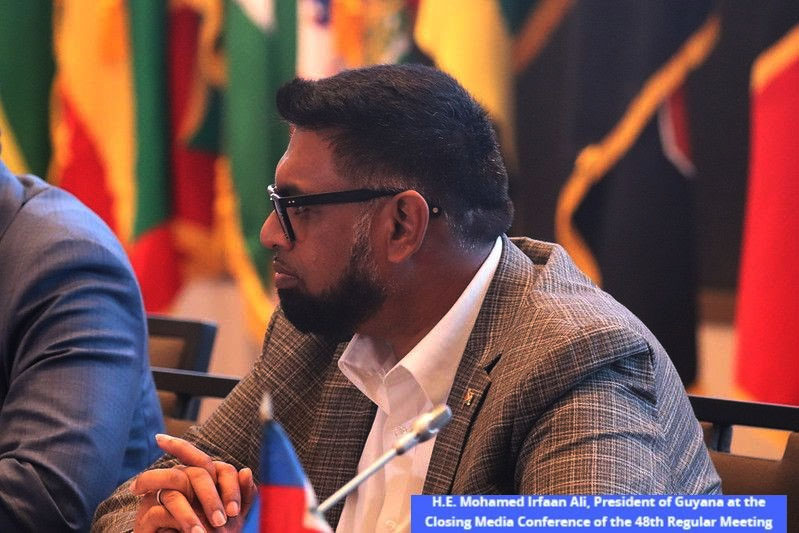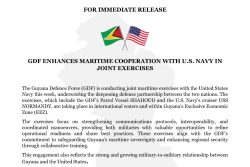-Ali cites trade uncertainties, natural disasters
An ambitious CARICOM plan to cut food imports by 25% by the end of this year has now been extended to 2030.
Guyana’s Head of State, President Irfaan Ali, on Friday announced the extension of the CARICOM 25 by 2025 regional food security initiative, citing uncertainties in the global trade arena coupled with impacts from natural disasters in the region as some of the factor that influenced the decision.
President Ali made this announcement on Friday, February 21, in his capacity as Lead Head of Government with responsibility for agriculture and food security in the CARICOM Quasi Cabinet, at the conclusion of the 48th Regular Meeting of the Conference of Heads of Government of the Carib-bean Community (CARICOM) which was held in Barbados.
New goals have also been added to the Initia-tive. The extension came despite optimistic and upbeat estimates from Ali and others in recent years.
While acknowledging the “significant” progress made to date under the Initiative, Ali pointed to the devastating consequences of Hurricane Beryl on the agriculture sector and continuing global supply chain disruptions.
“In relation to our 25 by 2025 programme… we have made significant pro-gress. If you look at 2022 to the end of October/ November 2024, we have had about a 24 per cent increase in food production across the region. We have had major investments in infrastructure to support food production, whether it’s cold storage, farm-to-market access roads, solar dryer facilities, loan approvals, [or] establishment of dairy facilities. We have seen significant an increase in private sector investment and lending in the agriculture sector and the food production chain within the Region,” Ali told the media .
He also noted that given the current situation, the region has established a “holistic framework” to build a resilient, sustainable and competitive industry and food system that will encourage participation, particularly by the youth and women.
The CARICOM release provided no information on the progress to date in relation to a reduction of imports by 25%. Not even in Guyana has there been specific information on the cutting of imports though the cultivation of soybean and corn has been cited.
“We have seen private investors sow 10,000 acres of corn and soya beans in 2023, with projections for 26,000 acres by the end of 2024 and 30,000 acres by the end of 2025. “This will take us to self-sufficiency in 2025 for us to produce all of our livestock feed for our country’s needs… And for us to be a net exporter in the Caribbean”, Agricul-ture Minister Zulfikar Mustapha had said at the end of 2023.
In July last year, Ali said that the 25 by 25 would see setbacks due to the impact of Hurricane Beryl on a number of countries’ agricultural sector and other sectors.
“It is important to note that Grenada, St Vincent and the Grenadines, Jamaica, St Lucia, and Barbados, were all islands and countries that were on track mostly in achieving the 25 by 2025 targets set by themselves,” Ali said in an address on the impacts of the hurricane that has devastated some countries.
“I asked the chair of the ministerial task force to give me an assessment and from his assessment, it is sad, with its immediate effect, that Hurricane Beryl in some instances would have damaged or completely wiped out the agricultural sector,” he added.
Ali said that Hurricane Beryl has been an impediment to those plans, since not only is the initial investment and cost of damage concerning to him as the Lead Head in Agriculture, but looking at the long-term investment costs to rebuild the infrastructure, to find resources and recapitalize the farmers, was heartbreaking.
“As you know most of the farmers and fisherfolk are not insured, a lot of the crops damaged are long term crops also, seven years duration to maturity, …to get high yielding variety, to get intercropping in place whilst reinvestment is placed in those long-term crops,” he lamented.
He said this was why a lot of short, medium and long-term issues in the agricultural sector, in the region, must be addressed in a comprehensive way.
In Barbados, for example, he pointed out, the fisheries sector which accounts for a significant part of catering to its tourism market, has faced serious setbacks.
“When you have a situation where …agriculture in general but specifically the fisheries sector is severely damaged, it requires tremendous investment for infrastructure, retooling, grants, sorting the initial livelihood of fisherfolks, getting back their assets so that they can go back to making their livelihood,” Ali reasoned.
“But when you have that compounded by the main revenue earner of the country being affected by tourism, it tells you the magnitude of how the situation is amplified. So in Barbados, the fisheries sector was tremendously affected. From our initial assessment, one-third of Bridgetown’s fishing harbour was destroyed, and over 200 fishing vessels were damaged and des-troyed, severely impacting the fishing industry. And of course, the families of the fisherfolks there in Barbados have suffered not only tremendous loss of assets but loss of livelihood,” he added.
Apart from the fishing sector, he pointed to Barbados’ agricultural sector where he said, “hundreds of acres of agricultural commodities were lost.”
Turning to Grenada, Ali noted the devastation and wipe out on the islands of Carricaou and Petite Martinique. “The livestock, permanent crops, cash crops, all the investment in agriculture were completely destroyed in these two islands, whilst in Grenada, there has been a tremendous impact on the agricultural sector and production. As I said, the assessment there and in the other islands is continuing, but we are very concerned about the immediate and medium-term ability of Grenada to quickly get its productive capacity in agriculture,” he said.
Ali said he spoke to St Vincent and the Grenadines Prime Minister Ralph Gonsalves and it was heart-wrenching there. “St Vincent was also making tremendous strides in the 25 by 2025 action plan. In St Vincent, an initial assessment shows you have more than 80% damage and losses to agriculture. Immediate production has been taken out that will affect cost, livelihood, and supply. Supply and demand have a relationship with price as we know. On Union Island, almost 100% of the agriculture… was completely lost. These islands depend heavily on permanent crops, whether it is the fruit trees that are important but in the case of St Vincent and the Grenadines, the bananas, the plantains, livestock, and vegetables… the losses have been enormous,” he noted.
Over in St Lucia, though the losses were not as terrible as in Grenada and St Vincent and the Grenadines, Ali said that “there will also be tremendous setbacks in the 25 by 2025 plan.
“Thirty five percent of the islands’ bananas and plantains production have been affected. That is the initial assessment. More than 100 acres of agricultural commodities including vegetables, roots and tubers, permanent crops and corn production have been taken out of the system. For those of us in larger land and agricultural land space we must understand that 300 or 400 acres of agricultural production in vegetables and root crops and so on, plantains, and bananas have a tremendous effect on the economy and livelihood of these countries,” he informed.
Jamaica also suffered extensive damage in agricultural areas. “This damage is as I said, just as in the other countries where current production has been taken out of the system and in most of the cases here it is the rural farmers and rural communities that have suffered the most and the investment required to bring back these communities into productive capacity is going to be enormous. So, whilst the initial effort is around current needs, we have this immediate medium and long-term situation as a result of Beryl on countries that have been affected,” he noted.
In 2022, following the conclusion of the Caricom Heads of Government meeting in Suriname, a communique said that the majority of Caricom member states had developed and submitted to the Ministerial Task Force (MTF) on Food Production and Food Security, their national targets which were expected to help achieve the lowering of food imports by 25% by 2025.









